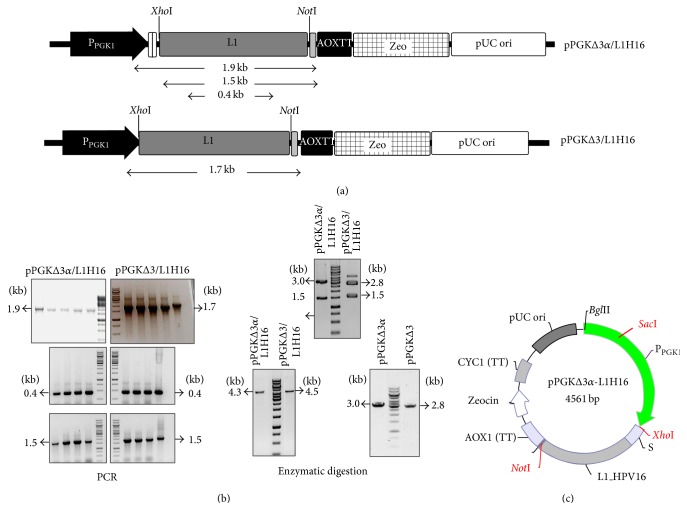Figure 1.
Construction of cassettes for HPV16 L1 gene expression under the control of PPGK1. (a) Schematic illustration of the two expression cassettes in which fragment lengths are highlighted for the confirmation analysis: primers flanking part of the PPGK1 and the L1 gene render a 1.9 kb fragment from the pPGKΔ3α/L1H16 vector and a 1.7 kb fragment from the pPGKΔ3/L1H16 vector; primers flanking the L1 gene renders a 1.5 kb fragment from both vectors; internal L1 primers render a 0.4 kb fragment from both vectors. (b, left panel) Expression vectors were extracted from recombinant bacterial strains and subjected to PCR analysis: the three DNA fragments predicted in (a) were amplified from the extracted DNA plasmids. (b, right panel) Extracted DNA plasmids were further confirmed by restriction digestion with XhoI and NotI enzymes (upper line), through which the release of the L1 gene (1.5 kb) could be observed, along with the presence of pPGKΔ3α (3 kb) and pPGKΔ3 (2.8 kb) vectors. After confirmation by PCR and restriction digestion, the PPGK1-based cassettes were linearized with SacI (lower line) prior to transformation of P. pastoris. (c) Map of pPGKΔ3α-L1H16. PGK1 promoter and AOX1 transcription terminator regions are flanking the L1 gene at its 5′ and 3′ ends, respectively. Besides the E. coli pUC origin and zeocin selection maker, this construct carries a codon-optimized S. cerevisiaeα-MF (S) downstream from the PGK1 promoter, which is absent in the pPGKΔ3/L1H16 vector. The positions of XhoI, NotI, and SacI restriction sites are also highlighted on the map. The map is merely illustrative and there is no correlation between the sizes of the highlighted regions.

